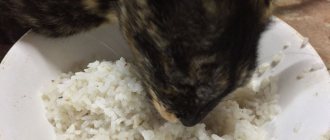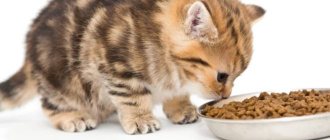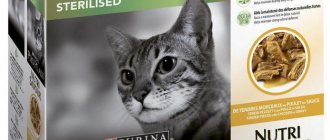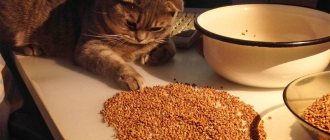The article examines the main arguments of owners for feeding cats fish, lists the main dangers of eating fish for pets, what types of fish can be given and which ones should be avoided. From the material you will learn how to properly feed cats with fish, the basic feeding rules for castrated cats, sterilized cats and kittens.
-Can I have some fish?
Why cats should be given fish: arguments from owners
The question of whether cats can be given fish has worried many generations of owners of these animals. The opinions of the owners are divided: some claim that fish is a mandatory ingredient in the cat’s menu, as it is rich in nutrients, while others recommend abandoning this product.
Most owners believe that fish is a natural product on the cat’s menu, since in nature they most often eat it. However, this is an erroneous opinion - the main part of the cat family cannot and does not know how to fish. There are several breeds of cats that are fishermen and love water activities, but fish has never been the basis of their diet. People added fish to a cat's diet, since it is easier to feed a pet with small catches than to look for birds and mice for it.
The civet cat is perhaps the only cat species that is distinguished by a strong attachment to bodies of water, as it feeds mainly on fish. The animal sits in ambush on the shore, and when a fish approaches it, it jumps into the water and with one precise blow of its clawed paw throws it ashore. Thanks to this method of hunting, the animal received the name fishing cat.
Fishing cat on the hunt
Here are a few arguments from owners who believe that they need to add fish to their cat’s diet:
- “My friend’s cat loves fish and eats it all her life.” Each animal is individual: some have good health, others have allergies and other negative consequences. You should not transfer someone else's experience onto your pet.
- “In villages, all cats eat fish.” According to statistics, the lifespan of village cats is shorter than that of domestic city cats. Of course, many factors influence life expectancy, and a fish diet is considered one of them.
- “Fish oil is an essential food for cats.” It can be replaced by including special supplements in your cat's diet.
Many cats really like fish and get used to it easily. Fish is a healthy product. The protein contained in fish is easier to digest than meat. Fish also contains vitamins (especially a lot of A, B1, B2, D and E) and minerals (phosphorus, calcium, iron, zinc, magnesium and selenium). Fatty fish are a source of fatty acids - Omega-3 and Omega-6.
Cats not only enjoy eating fish, but also watching them.
Dry pollock meat
To determine the juiciness of a fish, you need to determine its water-holding capacity. This indicator is very important. It indicates the process of protein denaturation and the quality of muscle tissue. The fresher the fish and the less the fillet has been exposed to temperature fluctuations, the higher this indicator.
According to the quality requirements for fish products, the water-holding capacity must be at least 50%. Experts have found that the following brands of pollock meet these standards:
These varieties of fish can be considered the most juicy.
Why fish can be dangerous
Although fish is a fairly healthy product, there are dangers when adding it to a cat's diet. The main dangers that arise when a cat consumes fish:
- Allergy. Fish ranks high on the list of the most allergenic foods for cats. If your cat's diet contains fish, and the animal regularly suffers from digestive disorders, her eyes often water, or there is nasal discharge, her fur has become dull, there is a high probability that she has developed an allergy to this product.
- Urolithiasis disease. With the constant presence of fish in a cat’s menu, the functioning of the kidneys and urinary tract is complicated.
- Obesity. It is caused by a deficiency of vitamin E in combination with an excess of fatty acids. The cat's fur becomes dull, lethargy appears, the temperature rises and the appetite disappears.
- Metabolic disease. It occurs due to a lack of vitamin B1, which is involved in all metabolic processes. It is destroyed under the influence of a special enzyme concentrated in the head and entrails of the fish. The most dangerous fish in this regard are carp, bream, herring, capelin, crucian carp, chebak, pike, smelt, burbot, sprat, anchovy, tench, sea bream and sea catfish.
Fish can be dangerous for your cat
- Iron-deficiency anemia. Anemia is observed in cats that are fed pollock, capelin, winter herring, cod, and silver hake. Due to the hormone contained in this fish, the pet’s body does not absorb iron.
- Reduced blood clotting. Fish is not able to support the production of vitamin K, which is responsible for proper coagulation. Cats can produce their own vitamin K from most foods, but a fish-based diet does not support adequate levels of this vitamin.
- Digestive disorders. Occurs due to the abundance of fatty pulp or monotonous feeding, when the cat is given only caviar, milt or fish heads.
- Bone injury. The fish skeleton consists of very dangerous small and large bones that easily get stuck in the larynx, esophagus and even intestines.
- Worm infestation. Infection occurs when eating raw or insufficiently processed fish with parasite larvae. Carp fish species are especially dangerous in this regard.
- High toxicity. This is explained by the presence of heavy metal salts, pesticides and other poisons in water bodies, which can accumulate in the body for years.
What types of fish can you feed cats?
Many cats enjoy the smell and taste of fish. When choosing what kind of fish, sea or freshwater, you can give to cats, stop at the first one.
Ocean and sea fish are rich in various microelements. Sea fish meat contains many important vitamins (A, B, D and E), as well as a large complex of minerals such as phosphorus, magnesium, calcium, as well as iodine, zinc and copper - improving metabolism, bromine, iron, fluorine, which normalize the functioning of the thyroid gland.
Sea fish is less contaminated with heavy metals than freshwater fish and does not contain pesticides.
An invaluable property of sea and ocean fish is its content of Omega-3 – polyunsaturated fatty acids. This is an important component in a cat’s diet; it supports the pet’s immunity, has a positive effect on the condition of the joints and the functioning of the nervous system.
The most useful and harmless fish growing in the wild are considered to be fish of the salmon family: salmon, chum salmon, pink salmon, coho salmon, sockeye salmon, omul, taimen, lenok and grayling.
Delicious dreams of a cat
Raw or cooked
It is not recommended to feed cats raw fish, especially river fish or fish from the carp family. This is due to the fact that the product may contain parasites. Constant consumption of raw fish often leads to helminthic infestation. Veterinarians recommend feeding cats only raw fish from the cod family, which does not contain parasites.
Fish should be added to your cat's menu boiled and in moderation. It should be remembered that it is necessary to remove bones from the fish.
Canned fish
Many cats love canned fish, even more than fresh. But do not forget that fatty varieties of canned fish (for example, herring) have a laxative effect on cats.
It is strictly contraindicated to give your cat canned cod liver - such food will be too fatty due to the large amount of oil.
Is it possible to give a cat smoked, salted fish or river fish with bones?
Veterinarians strictly prohibit giving cats smoked and salted fish. Smoked food is very difficult for a cat and has a devastating effect on the liver. As a result of cooking such fish, carcinogens are formed that negatively affect the gastric mucosa and lead to the risk of developing tumors. Salted fish contains a lot of salt, which is contraindicated for cats. Excess salt provokes cramps, diarrhea, excessive urination, lethargy and increased thirst. The cat can die within 24 hours.
Do not offer your cat smoked and salted fish, it is dangerous
River fish with bones should not be given to cats. It is the bones that cause many problems and visits to the veterinarian:
- Bones can cause damage to the larynx while the cat chews the meat;
- Sharp fragments scratch the esophagus as they pass through it and cause injury and bleeding;
- In the stomach and intestines of an animal, sharp bones lead to inflammatory processes or sepsis.
A fish bone can only be removed from a cat's body under general anesthesia, and an x-ray must first be taken.
Be sure to remove fins and gills before feeding fish to your pet. They can cause great harm to the cat’s stomach and intestines - scratching the walls and thereby causing bleeding and indigestion.
Gobies
Many people deliberately buy bulls for their cats, which they even give them raw. At the same time, no one thinks about the fact that this fish lives in polluted waters, which is why it often comes to the pet already infected with a variety of parasites, which are not at all harmless to its health.
In addition, a rare owner, pampering his cat with raw bulls, thinks about hard bones, which can even harm the pet. By the way, the same can be said about sprat, which some people love to buy for cats in order to pamper them with tasty and “healthy” food.
What fish should you not give to cats?
Freshwater fish is considered the most harmful product to feed a cat. The inhabitants of reservoirs contain excess heavy metals, pesticides and other toxic substances.
According to research, it has been revealed that 95% of river fish are infected with parasites. Most of them are found in the following types of freshwater fish: crucian carp, pike, carp, roach, bream and carp. These parasites lead to the disease opisthorchiasis
Sea fish is 25% less susceptible to parasites than river fish, but its consumption without heat treatment is not safe. In terms of the degree of worm infestation, the leaders are: mackerel, herring, sprat, blue whiting, anchovy and goby.
Small raw fish are dangerous because of their sharp and thin bones, which can damage internal organs and cause inflammation. Large species of river fish (carp, pike) are also dangerous due to the presence of small bones.
Carps are big and tasty, but they have a lot of sharp bones
Fish in dirty waters contain many dangerous substances. If you give cats such fish, heavy metals will accumulate in its body. Farmed fish have meat that contains carcinogens because they are bred using antibiotics and artificial feed. After eating such fish, dangerous substances accumulate in the cat’s body, which lead to the development of serious diseases.
Can a neutered cat fish?
It is believed that after castration, the chance of developing urolithiasis may increase. Therefore, after the operation, many veterinarians recommend that owners completely exclude fish from the pet’s diet so as not to contribute to the development of a dangerous disease.
However, some veterinarians believe that it is possible to feed fish in small quantities, but once every two to three weeks and in small portions. In this case, the following conditions must be observed: the product is low in calories, boiled, and the cat is not overweight.
A package of pollock fillets contains more ice than fish
There are technical regulations according to which the ice crust content in fish fillets should be no more than 5%. Experts found that thirteen brands of pollock meet this standard, and two do not.
However, it is important to take one detail into account. The actual net weight of the fish after defrosting must be equal to the declared fillet weight indicated on the packaging. All fifteen brands of pollock met this standard, including those where the ice crust content exceeded the norm. This suggests that the buyer is not being shortchanged. He pays for the weight of the fish that was declared.
A thick crust of ice is not a disadvantage. It protects the fillet from spoilage and loss of liquid. A large amount of ice glaze only affects the duration of defrosting, but does not affect the taste of pollock.
Is it possible to feed a kitten fish?
Veterinarians suggest that twice a month you can feed your kitten boiled fillets of sea fish, such as pike perch, flounder and cod. Fish should be lean and boneless.
Fish contains many fatty acids and microelements that are beneficial for a kitten, but frequent consumption can harm its health, as it interferes with the full absorption of vitamins B and K, which upsets the balance of phosphorus and calcium in the animal’s body.
Fish is good for a growing kitten, and a toy in the shape of a fish will cheer you up
How to properly give fish to cats, feeding frequency
You can add fish to your cat’s menu no more than 1-2 times a week, as it is addictive. Fish should be given to the cat boiled - after a little heat treatment, the protein will be better absorbed by the body. In addition, high temperature kills parasites and their eggs, which are often found in the insides of fresh fish.
Some feeding tips:
- Boiled fish should be without scales, bones and entrails;
- Cook fish without salt and spices;
- Fillets of sea and ocean fish must first be frozen;
- Give preference to low-fat fish: salmon, cod, halibut, hake;
- It is advisable to serve fish in combination with vegetables, seaweed or cereals;
- Stale food is not acceptable.
The quality and freshness of the fish should come first when choosing a product for your pet. Fresh produce will emit a pleasant aroma; the gills should be light. By pressing the fillet with your finger, it will retain its shape and will not fall off the sides.
Young cats can be periodically pampered with fatty fish, but mature cats are better fed exclusively with dietary varieties. During pregnancy, you should not feed your cat fish. Castrated and sterilized cats are fed fish no more than 2 times a month.
During the cold months, you should add fish oil to your pet's food, which contains vitamins A and D. It is better to exclude red fish from your pet's menu, as it has a negative effect on digestion.
If owners feed their cats factory-made food, then there is no need to add fish to the menu. This can lead to digestive system disorders. It is important to note that when preparing ready-made feed with the addition of fishmeal, the daily consumption rate is taken into account, so problems for the animal’s body are eliminated.
Fillet is subjected to repeated freezing and thawing
Pollock meat is lean. If the fillet is re-frozen, it becomes excessively dry and tough. Experts have determined the percentage of deep dehydration of fish. This indicator indicates whether the fillet has been refrozen.
In thirteen pollock varieties, deep dehydration did not exceed 10% of the total mass. This indicator is the norm. This means that they were not defrosted during transportation. Only in two brands (Fine Life and Flipper) did deep dehydration exceed the norm several times.











